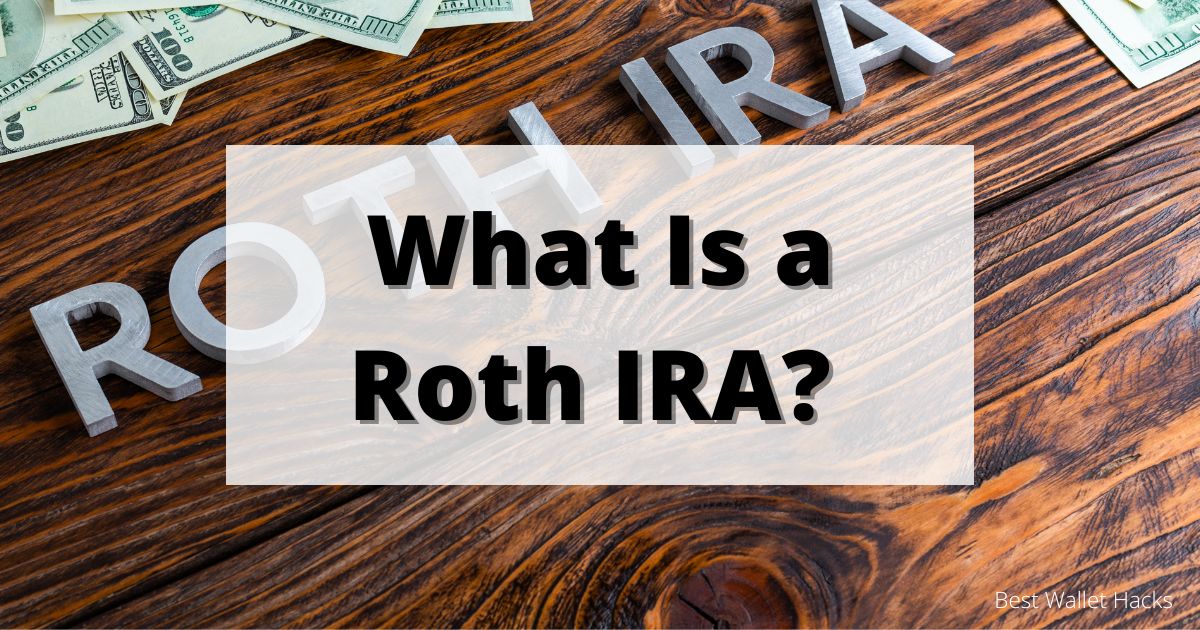What Is a Roth IRA?

Roth IRAs are a relatively recent addition to the lineup of tax-sheltered retirement plans, only coming into existence in 1998. Since then, they’ve become very popular. That’s because Roth IRAs provide unique tax advantages that you can’t get with any other retirement plan. So what is a Roth IRA, and should you include it in your retirement portfolio? We answer those questions and more in this article.
Table of Contents
A Roth IRA is an Individual Retirement Account that provides unique income tax benefits. Though your annual contributions to a Roth IRA are not tax deductible, the investment earnings accumulated within the plan are tax-deferred.
The major advantage to saving in a Roth IRA occurs when you reach age 59 ½ – and have been participating in a Roth plan for at least five years. Once you reach those milestones, withdrawals taken from a Roth IRA are completely tax-free. That includes both the contributions you have made to the plan as well as your accumulated investment earnings.
Simply put, a Roth IRA allows you to draw tax-free income in retirement. Though it’s normally thought income – and your income tax bracket – will be lower once you reach retirement age, that isn’t always true. Many retirees have substantial, multiple income sources in retirement. A Roth IRA is the perfect way to reduce the tax liability of that situation.
Traditional IRA vs. Roth IRA: Similarities and Differences
In many respects, traditional and Roth IRAs have a lot in common. Both are plans designed for individual taxpayers and not sponsored by an employer. They can be funded only out of earned income. Virtually anyone who has earned income can contribute to either plan. Both plans also offer tax-deferred accumulation of investment earnings and the ability to set up an account with a bank, investment broker, or mutual fund family of your choice.
That’s about where the similarities end. The table below details the similarities and differences between traditional and Roth IRAs.
| Feature | Traditional IRA | Roth IRA |
|---|---|---|
| Maximum contribution (2023) | $6,500 + $1,000 if you are 50 or older | $6,500 + $1,000 if you are 50 or older |
| Contributions tax-deductible? | Yes, in most cases | Never |
| Contribution limited by income | No* | Yes |
| Tax deferral of investment earnings | Yes | Yes |
| Investment options | Nearly unlimited | Nearly unlimited |
| Tax on early distributions | Ordinary income tax + 10% penalty | No tax or penalty on withdrawals of contributions; ordinary income tax + 10% penalty on investment earnings withdrawn |
| Distributions taxable in retirement | Yes | No |
| Subject to Required Minimum Distributions | Yes | No |
| Spousal IRA option | Yes | Yes |
*There are no income limits for making contributions to a traditional IRA, but the deductibility is limited if you or your spouse are covered by an employer plan and your income exceeds certain limits. See Roth IRA Participation Income Limits below.
Roth IRA Tax Considerations
As mentioned, Roth IRA contributions are not tax-deductible, but investment earnings are tax-deferred. You can take distributions from the plan tax-free once you reach age 59 ½ and have participated in a Roth plan for at least five years.
One of the major advantages of a Roth IRA is that since contributions are not tax-deductible, you can withdraw them at any time without incurring tax consequences. In fact, the IRS allows you to withdraw your contributions before any accumulated investment earnings. That means your contributions can be withdrawn without being subject to either ordinary income tax or a 10% early withdrawal penalty.
Five-year requirement: Besides the age requirement, Roth IRA tax-free withdrawals require you to participate in a plan for at least five years. If you’re over 59 ½, but you have not participated in a Roth plan for the five-year minimum, the accumulated investment portion of your distribution will be subject to ordinary income tax but not the 10% early withdrawal penalty.
Roth IRA Participation Income Limits
The Roth IRA has a major income-related limitation. That is, you can only contribute up to a certain income limit. Once your income reaches that limit, you cannot contribute.
This differs from the traditional IRA. While there are income-based contribution limits, you can still make non-deductible contributions, even if your income exceeds those limits.
Not so with a Roth IRA. The IRS imposes the following limits on Roth IRA contributions based on income for 2023:
Married filing jointly or qualified widow(er): Full contribution up to a modified adjusted gross income (MAGI) of $218,000, gradually phase out up to $228,000, after which no contribution is permitted.
Married filing separately and you lived with your spouse at any time during the year: Partial contribution up to a MAGI of $10,000, after which no contribution is permitted.
Single, head of household, or married filing separately, and you did not live with your spouse at any time during the year: Full contribution up to a MAGI of $138,000, gradually phase out up to $153,000, after which no contribution is permitted.
Required Minimum Distributions (RMDs)
Though retirement plans provide generous tax benefits, the IRS does include a gotcha provision. Most tax-sheltered retirement plans are subject to RMDs, which require that distributions begin by age 73. This requirement forces you to draw taxable income from your retirement plan.
The distributions are based on a percentage of the plan, as determined by your age at the time of the withdrawal. Because life expectancy declines with age, the required withdrawal percentage will increase yearly.
This is another major tax advantage for Roth IRAs. The Roth IRA is the only retirement plan offered that’s exempt from the RMD requirement. That means you can allow your Roth IRA to continue growing for the rest of your life.
This presents two advantages:
- A Roth IRA can be a way to preserve assets to pass on to your heirs.
- The account can function as a late-stage source of funds for retirement income. You can delay taking distributions until you’re 75, 80, 85, or any age you choose.
Who Is Eligible to Open a Roth IRA?
Virtually anyone with earned income can participate in a Roth IRA, whether or not they participate in an employer-sponsored retirement plan – subject to the income limitations described above.
You can make a full or partial contribution up to the amount of income you earn. For example, if you earn at least $20,000, you can make a full $6,500 Roth IRA contribution in 2023. But if you only earn $5,000, your contribution will be limited to $5,000.
Earned income is income from a job, self-employment, freelance, or contract work. It does not include unearned income, like interests and dividends, capital gains, passive income sources (rental real estate, royalties from oil and gas, etc.), or income derived from Social Security, pensions, annuities, child support, alimony, or insurance distributions.
Spousal Roth IRAs. Non-working spouses can make a spousal Roth IRA contribution. Both income-earning and non-earning spouses are eligible to make contributions based on the amount of earned income from the income-earning spouse. Thus, if the income-earning spouse generates $50,000 in income, each spouse can make a Roth IRA contribution of up to $6,500 or $7,500 if they are 50 or older in 2023.
The couple can make Roth IRA contributions of $13,000 or $15,000 if they are both 50 or older. The couple must also file a joint tax return to be eligible for the spousal IRA contribution.
Be aware of this limitation! If you choose to participate in both a traditional and a Roth IRA, your combined contribution to the two plans cannot exceed the $6,500/$7,500 contribution limit in 2023. For contribution purposes, the two plans are considered as one.
Roth IRA Pros & Cons
The Roth IRA has many benefits and some limitations. Knowing how to use the plan to your advantage is critical. Here’s our list of IRA pros and cons.
Pros:
- Investment earnings accumulate on a tax-deferred basis.
- You can begin taking tax-free withdrawals on contributions and earnings once you turn 59 ½ and have participated in a Roth plan for at least five years.
- An excellent tax diversification strategy that allows part of your retirement income to be tax-free.
- Because contributions are not tax-deductible, they can be withdrawn at any time without tax consequences.
- Roth IRA accounts are not subject to RMDs, so the account can continue to grow for the rest of your life.
- Like a traditional IRA, investment options in a Roth IRA are nearly unlimited.
Cons:
- Contributions to a Roth IRA are not tax-deductible.
- You will not be eligible to contribute if you exceed the annual income limit for your tax filing status.
- The annual contribution amount is low compared to employer-sponsored plans, like a 401(k).
Where to Open a Roth IRA
The best way to open a Roth IRA is through an online investment broker. Start by choosing an investment broker that offers Roth IRAs.
There are plenty of choices. Ally Invest and Robinhood are low-cost options for self-directed investors. Both enable you to participate in commission-free trading of both individual stocks and funds. Robinhood even offers trading in cryptocurrencies.
If you prefer a managed option, consider a robo-advisor platform like Betterment or Wealthfront. You can begin investing with very little money upfront for an annual fee of around 0.25%. You’ll benefit from comprehensive investment management, including automated portfolio construction.
If you like the idea of using a robo-advisor but prefer to select your own investments, M1 Finance is an excellent choice. You can open an account with no money and begin investing with as little as $100. You can select the stocks and ETFs that will be held in your investment account, and M1 Finance will provide complete management with no advisory fee.
Should You Open a Roth IRA?
With the clear benefits that the Roth IRA offers, it would seem logical that everyone should have one. But that’s not true in all cases.
Naturally, you’ll not be able to participate in a Roth IRA if you exceed IRS income limits for the plan. An alternative strategy would be to make a non-deductible contribution to a traditional IRA. However, from a tax standpoint, the benefit is not as clear as it is with a Roth IRA contribution. You should discuss this strategy with your tax advisor to see if it is in your best interests.
Because Roth IRA contributions are not tax-deductible, it may work to your advantage to make a traditional IRA contribution, at least if it will be deductible. For example, if you don’t have access to a retirement plan at work and are in the 37% tax bracket for federal income tax and 8% for your state, the tax savings could be equal to 45% of your contribution to a traditional IRA. You won’t get that benefit with a Roth IRA contribution. (if you are covered by a retirement plan, check with your accountant as those in the 37% tax bracket would not be able to deduct traditional IRA contributions due to the income limits)
Finally, you’ll need to do your best to estimate your tax liability will be in retirement. A Roth IRA contribution may not make sense if you are in a high tax bracket now but expect a much lower tax bracket in retirement.
For example, if you are in the 37% tax bracket now and expect to be in the 12% bracket in retirement, you may be giving up a generous tax break now for a very limited tax benefit in retirement.
Other Posts You May Enjoy:
Fundrise Review 2023: Commercial Real Estate Investing for Just $10
Fundrise is a private market real estate investing platform where you invest in eREITs (electronic REITs) that aren’t traded on the public markets. Which is unique since it’s usually REITS that invest in commercial real estate and crowdfunding typically invest in residential.
Why Dave Ramsey’s Investing Advice is Extremely Dangerous
Dave Ramsey offered up some dangerous financial advice on his radio show last week. He claimed that 8% withdrawal rate on a $1 million nest egg will last you forever – there’s a 67.5% chance it won’t.
Can I Use My 401(k) to Buy a House?
With the median price of a house now over $430,000, qualifying for a mortgage more difficult than ever. And for many prospective homebuyers, coming up with a down payment seems nearly impossible. That’s why more and more people are asking the question, “Can I use my 401(k) to buy a house?” The short answer? It’s complicated. Learn more.
How to Become a More Patient Investor
The best investors are the most patient ones. But how do you become more patient? How do you learn to not touch your portfolio? I share a few strategies that have worked well for me.

About Kevin Mercadante
Since 2009, Kevin Mercadante has been sharing his journey from a washed-up mortgage loan officer emerging from the Financial Meltdown as a contract/self-employed “slash worker” – accountant/blogger/freelance blog writer – on OutofYourRut.com. He offers career strategies, from dealing with under-employment to transitioning into self-employment, and provides “Alt-retirement strategies” for the vast majority who won’t retire to the beach as millionaires.
He also frequently discusses the big-picture trends that are putting the squeeze on the bottom 90%, offering workarounds and expense cutting tips to help readers carve out more money to save in their budgets – a.k.a., breaking the “savings barrier” and transitioning from debtor to saver.
Kevin has a B.S. in Accounting and Finance from Montclair State University.
Opinions expressed here are the author’s alone, not those of any bank or financial institution. This content has not been reviewed, approved or otherwise endorsed by any of these entities.




